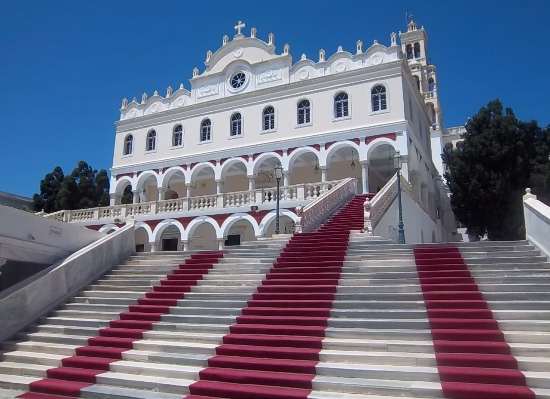
The Sacred Shrine of Panagia (Virgin Mary) of Tinos has been the most famous as well as one of the most popular pilgrimage destinations of Hellenism for Orthodox Christians. Thousands of believers have been reporting miracles, since the day when the icon was found until today.
The finding of the icon of Panagia Evangelistria and the most modern history of the Greek nation are identical. The finding of the icon of Virgin Mary in 1823 was considered as a divine omen for the Greek revolution.
A lot of believers, from all over the world, arrive at Tinos every year, to get Virgin Mary’s grace, to feel close to her and to get her blessing.
The story of the finding of the icon
The temple was built at the place where the thaumaturgical icon of Virgin Mary was found, after Pelagia’s, the simple and humble nun’s, visions.
For three consecutive weeks, (on Sunday 9,16,23/7/1822) Saint Pelagia was dreaming of Virgin Mary who was asking her to excavate the place in order to find her (Virgin Mary’s) icon that was buried in the fields of Ant. Doxaras, at Tinos’ main town. Saint Pelagia, under the escort of the Abbess, informed Gavriil, the Metropolitan Bishop of Tinos, who urged the people of the island to help to the excavation, by offering their money or their work.
At the beginning of September 1822, people willingly started to excavate in order to find the icon. As a result, the ancient temple of Dionysos and the temple of Saint John the Baptist (Prodromos) were discovered. However, as no icon was found, people were discouraged and stopped excavating. As the excavations brought out no result, people were scoffing Pelagia and were accusing her of being dreamy.
The works were repeated with more organization and now more tenacious efforts were made. Finally, on 30th January 1823, Dimitris Vlassis’ spade touched the thaumaturgical icon.
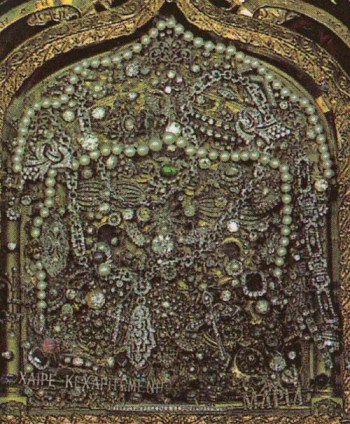
The role of the Icon to the Greek Revolution of 1821
Shortly after the finding, the news spread rapidly to the Greeks all over the world. This incident was considered maybe as the most important sacred message for the Greek Orthodox Christianity, for the sake of the Revolution. Kolokotronis, Miaoulis, Nikitaras and Makrigiannis arrived to the island to show their respect for the icon.
The chronicle of the construction of the temple
After the icon was found, the temple started to be built. Large amount of marbles were required that were mainly transferred from the nearby island of Delos. Also, a large number of workers was required for the elaboration and the placing of the marbles as well as a large amount of money, the lack of which had put the caretakers of this work into a difficult position as they could not pay both the workers and the materials at the end of the week. However, it always came as a miracle that they could manage to cope with every problem, as the people of Tinos and all the Christians in Greece and abroad offered generously a large number of workers and a large amount of money.
Until the middle of the year 1832, the eastern wing of the complex, the eastern part of the belfry and the eastern part of the central entry were erected. All the construction works were completed in 1880.
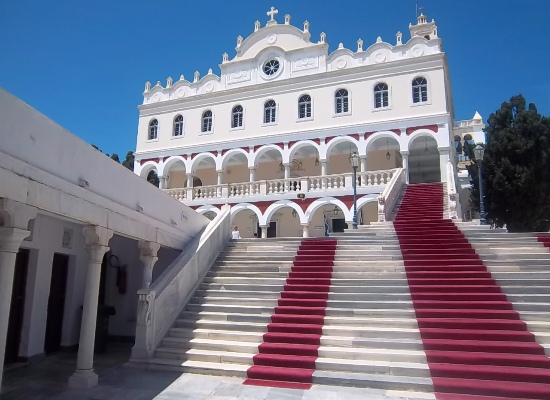
The temple
The imposing temple of Panagia of Tinos was founded in 1823. It was built at the exact place where the Icon of the Annunciation of Virgin Mary (Evangelismos tis Theotokou) was found, according to the vision of Saint Pelagia. It is one extraordinary building, made of white marble, which is the first remarkable architectural monument of the liberated Greek nation. It is situated in a prominent position in the main town of Tinos. The order of the church was chosen to be aisled basilica with a dome.
As you enter the temple from its central gate, on your left, you can see the iconostasis, where the thaumaturgical icon of Virgin Mary is held, which is full of believers’ offerings, as in every temple in Greece.
The order of the temple is aisled basilica with a dome above the Altar. The screen of the temple is carved wooden, its lower part is wooden and gilt and its upper part is made of plaster with wooden cornices, according to the design of the most important post-byzantine designers. It was constructed in 1825 by Fragiskos Kanahilis.
he Sanctuary is located three marble steps higher than the main temple and there are three apses. The central one is located behind the Altar, the eastern was turned into an Altar as a mark of honour for the Ascension of Christ and the western as a mark of honour for the Dormition of Virgin Mary.
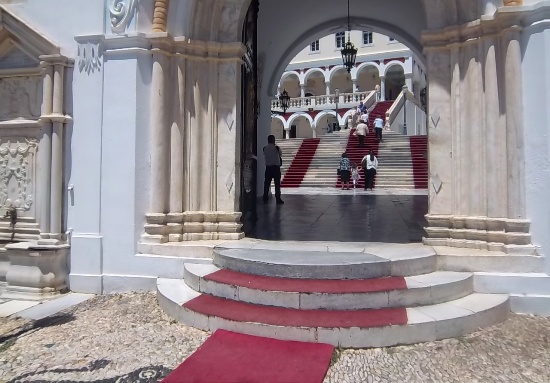
The temple hasn’t changed a lot until nowadays. The only things that have changed are its main face and the belfry.
n the 19th century, the temple of Timios Prodromos (John the Baptist) was in contact with the western part of the temple.
The temple of the finding
The temple is situated exactly below the temple of Evangelistria. It is the Place where the Sacred Icon was found and it’s also the place where the temple of Evangelistria was built. The temple that is situated downstairs consists of three domed arcades that are put in a continuous and parallel way with each other. The arcades communicate with each other with arches on the intermediate walls. The first arcade is the place where the Holy Water is situated and it’s also the place where the Sacred Icon of Virgin Mary was found.
The middle arcade is used mainly for baptisms.
The Chapel
This place is situated at the external entry of the complex where pilgrims can light a church candle. It is forbidden to burn these church candles in the main temple.
The Confessionals
On the western part of the floor, there are the Confessionals, where confession priests and spiritual fathers offer any kind of spiritual help to the pilgrims, preparing them for the sacrament of the Holy Eucharist.
The Institution
The PanHellenic Holy Institution of Evangelistria of Tinos is the fundamental and the most general form of the Church of Panagia (Virgin Mary) of Tinos. It is a charitable institution with great fortune that comes mainly from the offerings of the pilgrims to the Church. The Institution helps not only each and every pilgrim but also the Greek nation in general.
The Holy Institution of Evangelistria was established typically and essentially in January 1825, after the publication of the Testament of the Owners and the Establishers of the Pilgrimage. They created the testament of the Holy Institution of Evangelistria, setting its first administrative rules and defining Education and Philanthropy as its major aims.
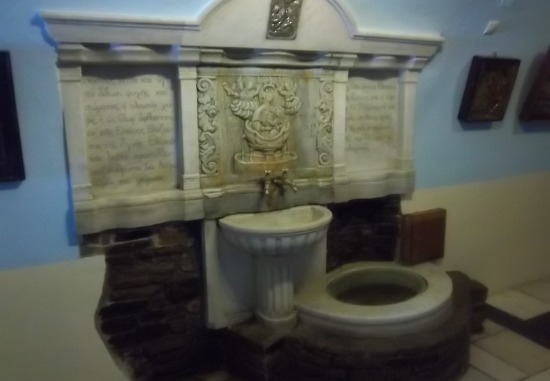
The four major celebrations
The celebration of the anniversary of the finding. (30th January).
It is the most important day for the island.
In the Afternoon of the Eve of the celebration, the sacred icon is transferred, followed by a procession to the downstairs temple and it is located near the spot where it had been buried for centuries. Then, Great Vespers is celebrated in a special way. Also, at night, a service takes place and thousands of believers take part in it.
The following day, a pastoral Holy Liturgy is celebrated and then the prayers for the departed are said and the laying of a wreath in front of the bust of the Archbishop Gavriil takes place. At 14.00, the procession of the Sacred Icon takes place, that is, the Icon is placed into a canopy that is raised with honour by the residents and the visitors of Tinos. The procession follows the same route that was followed in 1823, in the first procession of the Sacred Icon through the narrow streets of Tinos. On the platform of the waterfront, prayers are sung and the procession returns to the temple through the western part of the city.
The feast of the Annunciation
Up to 1920, the Greeks that lived in the non-liberated parts of Greece, that is the Greeks of Asia Minor, had been coming to Tinos by steamships and sailboats, in order to pray for the liberation of their lands.
Thousands of people keep coming to the island, even nowadays, despite the harsh weather conditions of this season.
On the eve of the feast of the Annunciation, Vesper is celebrated and, at night, the vigils and the Paraclesis are said. The temple stays open all night.
On the day of the Annunciation, Hierarchical Liturgy is celebrated, and then, the procession of the Sacred Icon starts and prayers are said at the beach.
Anniversary of Saint Pelagia’s Vision
This day is dedicated to Saint Pelagia, who, on the 23/7/1822, had the supreme honour to see Virgin Mary in her cell. Every year, on the 23/7, the icon is transferred to the Monastery of “Kiria ton Aggelon” (The Lady of the Angels) at Kehrovouni, where it stays all day. At the temple of Saint Pelagia, the Liturgy is celebrated and the Paraclesis is said. Thousands of people come to kneel before the Sacred Icon. The Abbess and the Nuns offer hospitality to the people who wait patiently for the returning time. Around 18.00, the clergy and thousands of people accompany the Sacred Icon to the city, on foot. The bells of the village churches and those of the chapels ring joyfully when the icon of Virgin Mary passes. Old people and those who can’t go to the Monastery go out and kneel before the Sacred Icon.
When the Procession reaches the city, prayers are said near the platform of the beach, fireworks are burnt and the Icon is transferred back to the Monastery late at night.
Feast of the Dormition of Virgin Mary (Kimiseos tis Theotokou) (15/8)
In the yard of the Temple, the Paraclesis is said every day from the 1st to the 15th August. On the Eve of the Feast, the island is decorated and it is swarmed with lots of pilgrims. Tinos is transformed into an enormous guesthouse.
A lot of people come to the temple either to bring offerings or to sing the Paraclesis or to show their gratitude to the Virgin Mary for helping them.
At night, the Great Hierarchical Vespers is celebrated, then the Paraclesis is said and the Holy Liturgy is celebrated. Finally, the Holy Communion is given to the believers.
The next morning, after the Holy Liturgy, the magnificent procession of the Sacred Icon follows. The canopy is transferred by Navy men.
Museums and collections
Since the beginning of the history of the temple, the owners have created an archaeological collection of findings from Tinos and Delos. Similarly, they have cared for the Church treasures.
Their initial attempts have led to the today’s impressively valuable museums which have not stopped being enriched and improved by the respective committees.
Icons’ and relics’ exhibition
This exhibition has been operating since 1956. Here, old icons are exhibited which were gathered by the Holy Institution of the parish churches of Tinos. The Institution has preserved them, showing the Orthodox Hagiographic tradition of the island.
Special reference should be made to the Charter of Rigas Fereos and specifically to one of the three originals that have survived, the patriarchal official report of the Ethno martyr Patriarch Gregory V and Theodoros Kolokotronis’ ring.
The Sacristy
In the rich sacristy of the Institution, there are parts of the offerings, mainly works of silver and golden embroidery which are exhibited in elegant showcases.
The Mausoleum of Elli
In the Mausoleum, there are the bones of the first victims of WW2 in Greece, who were members of the crew of the cruiser Elli, which was torpedoed in the port of Tinos in 1940.












